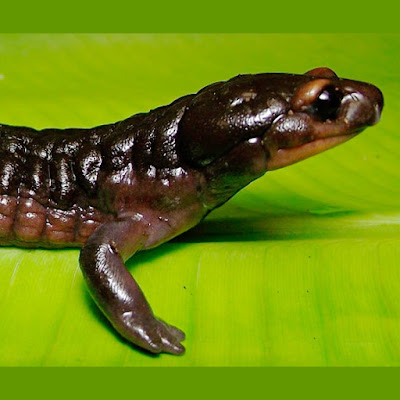[Most Recent Entries] [Calendar View]
Sunday, June 25th, 2017
| Time | Event | ||
| 9:17a | [Herpetology • 2017] Isthmura corrugata • A New Species of Isthmura (Caudata: Plethodontidae) from the Montane Cloud Forest of Central Veracruz, Mexico
Abstract We describe a new plethodontid salamander species of the genus Isthmura, known only from one locality in the mountainous region of central Veracruz, Mexico. Like its congeners, Isthmura corrugata sp. nov. has a large and robust body, but it is easily distinguished from the other species in the genus by the absence of any spot or mark on the dorsum (except by dull reddish brown coloration on eyelids) and by extremely well-marked costal grooves separated by very pronounced costal folds. Based on an mtDNA phylogeny, the new species is most closely related to the geographically distant I. boneti and I. maxima but occurs very near I. naucampatepetl and I. gigantea on the eastern slope of Cofre de Perote, Veracruz. The region where I. corrugata occurs contains a high number of plethodontid salamander species and is threatened by human activity. Keywords: Amphibia, Isthmura corrugata sp. nov., morphology, Neotropics, phylogeny, salamander Isthmura corrugata sp. nov. Suggested English name: Corrugated Salamander. Suggested Spanish name: Salamandra corrugada. Etymology. The specific epithet makes reference to the extremely pronounced grooves along the body, giving these salamanders a corrugated appearance Adriana Sandoval Comte, Eduardo Pineda, Sean M. Rovito and Ricardo Luria Manzano. 2017. A New Species of Isthmura (Caudata: Plethodontidae) from the Montane Cloud Forest of Central Veracruz, Mexico. Zootaxa. 4277(4); 573–582. DOI: 10.11646/zootaxa.4277.4.7 | ||
| 10:43a | [Ichthyology • 2017] Trichomycterus ytororo • Living in the Waterfalls: A New Species of Trichomycterus (Siluriformes: Trichomycteridae) from Tabay Stream, Misiones, Argentina Abstract A new species assigned to the genus Trichomycterus from the area of the waterfalls of Tabay stream, Paraná River basin, Misiones, Argentina, is described. Trichomycterus ytororo sp. nov. is distinguished from all other species in the genus by the presence of 31–35 dorsal procurrent caudal-fin rays and the combination of some external characters such as: coloration, number of pectoral–fin rays and pores of the laterosensory canals. The new taxon belongs to a presumably monophyletic group of species composed of T. crassicaudatus, T. igobi, and T. stawiarski based on the presence of 24 or more thickly ossified and rigid procurrent caudal-fin rays with a slender distal tip extending along the tips of at least ten neural spines.
Ecological notes: The Tabay stream basin through 192 km from its headwaters at Campo Viera to its mouth on the Paraná River, at Jardín América (Fig 4). The stream bed is mainly composed of basaltic bedrock, in which sections with waterfalls and pools alternates all along its run. At the type locality (Tabay waterfall; Fig 5), the stream is surrounded by remnants of the Paranaense riparian forest, with its left margin degraded due to a camping site. This waterfall consists of three consecutive falls, the main one is 10m high and 20–50m wide, which drains into a narrow gorge. All specimens of Trichomycterus ytororo were captured above the waterfalls at shallow areas (about 1 meter depth or less) or in rapids witha predominantly rocky bottom and strong current. Trichomycterus davisi was the single congener recorded at the type locality, which was not collected syntopically with T. ytororo. Distribution: Trichomycterus ytororo is so far known only from its type locality, the Tabay waterfalls in the Tabay stream (Fig 5), a tributary of the left bank of the Paraná River, province of Misiones, northeast of Argentina (Fig 4). Etymology: The specific epithet ytororo derived from the indigenous language Guaraní (“ytororõ”) which means “waterfall” in reference to the habitat occupied by the new species. A noun in apposition. Guillermo Enrique Terán, Juliano Ferrer, Mauricio Benitez, Felipe Alonso, Gastón Aguilera and Juan Marcos Mirande. 2017. Living in the Waterfalls: A New Species of Trichomycterus (Siluriformes: Trichomycteridae) from Tabay Stream, Misiones, Argentina. PLoS ONE. 12(6); e0179594. DOI: 10.1371/journal.pone.0179594 |
| << Previous Day |
2017/06/25 [Calendar] |
Next Day >> |






